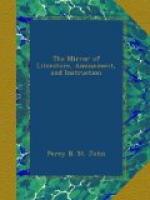The Cuts are but three vignettes from the architectural lore of the district. They stand in sheltered valleys, though, as their ruinous condition implies, their situation has not saved them from the destroying hand of time. Indeed, one of them, Beauchief Abbey, gives name to its locality, Abbey Dale, not far from the partition line that separates Derbyshire from Yorkshire. In this road, the ruin in the Cut is the first object that claims the attention of the tourist in his progress to the Peak; being part of a once magnificent abbey, founded by Robert Fitz-Ranulph, Lord of Alfreton; as an expiation for the part he is said to have taken in the murder of Thomas a Becket. The late Dr. Pegg, the antiquary, discountenances this tradition. His arguments, however, which are chiefly founded on the circumstance of the brother of Robert Fitz-Ranulph, being afterwards in great favour with Henry the Second, do not appear conclusive, particularly when opposed to the authority of Dugdale, Fuller, Bishop Tanner, and others who have written on the subject.[1]
[1] Dugdale says, “Robert Fitz-Ranulph, Lord of Alfreton, Norton, and Marnham, was one of the four knights who martyred the blessed Thomas a Becket, Archbishop of Canterbury; and afterwards founded the Monastery of Beauchief, by way of expiating his crime; in the reign of Henry the Second.” Bishop Tanner writes, “Beauchief, an Abbey of Promonstatentian, or White Canons, founded A.D. 1183, by Robert Fitz-Ranulph, Lord of Alfreton, one of the executioners of Thomas a Becket, Archbishop of Canterbury, to whom canonized, this monastery was dedicated.” These authorities are quoted by Mr. Rhodes. Sir James Mackintosh names the four “knights of distinguished rank,” (apparently upon the authority of Hoveden,) to have been “William de Tracy, Hugh de Moreville, Richard Britto, and Reginald Fitz-Urse.” We do not attempt to reconcile the conflicting chroniclers; but we should add, from the subsequent page, by Sir James, “the conspirators, despairing of pardon, found a distant refuge in the Castle of Knaresborough, in the town of Hugh de Moreville, and were, after some time, enjoined by the Pope to do penance for their crime, by a pilgrimage to the Holy Land, where they died, and were interred before the gate of the Temple.” Sir James describes the murder of Becket with minuteness: “the assassins fell on him with many strokes; and though the second brought him to the ground, they did not cease till his brains were scattered over the pavement.”—We know the Cathedral guide at Canterbury shows you the stone in the place of that on which Becket fell, and states the original stone to be preserved in St. Peter’s, at Rome; but the story is to us rather apocryphal. At St. Alban’s they show you the dust of the good Duke Humphrey: we once begged a pinch, which the guide granted freely; this induced us to ask him how often he re-supplied the dust: the man stared at our ungrateful incredulity.
The walls of Beauchief Abbey, with the exception of the west end, represented in the Cut, have long since either been removed, or have mouldered into dust. Parochial service is still performed in the remains; but the whole of the original form of the once extensive pile of building cannot now be traced.




